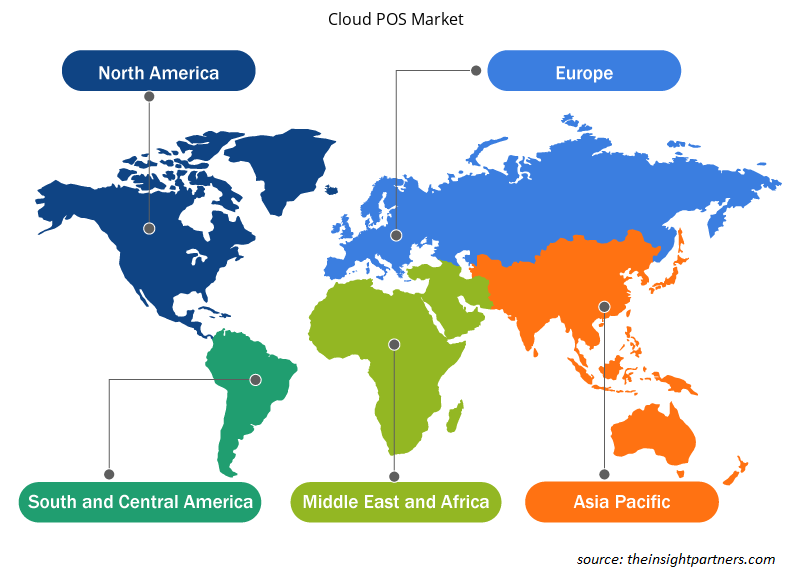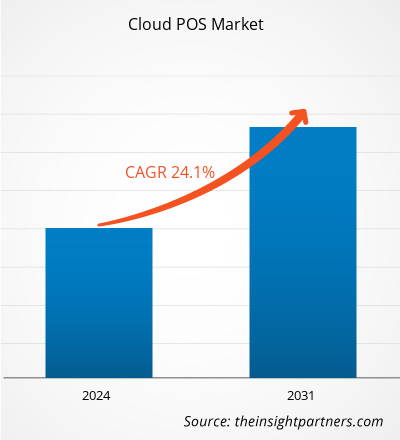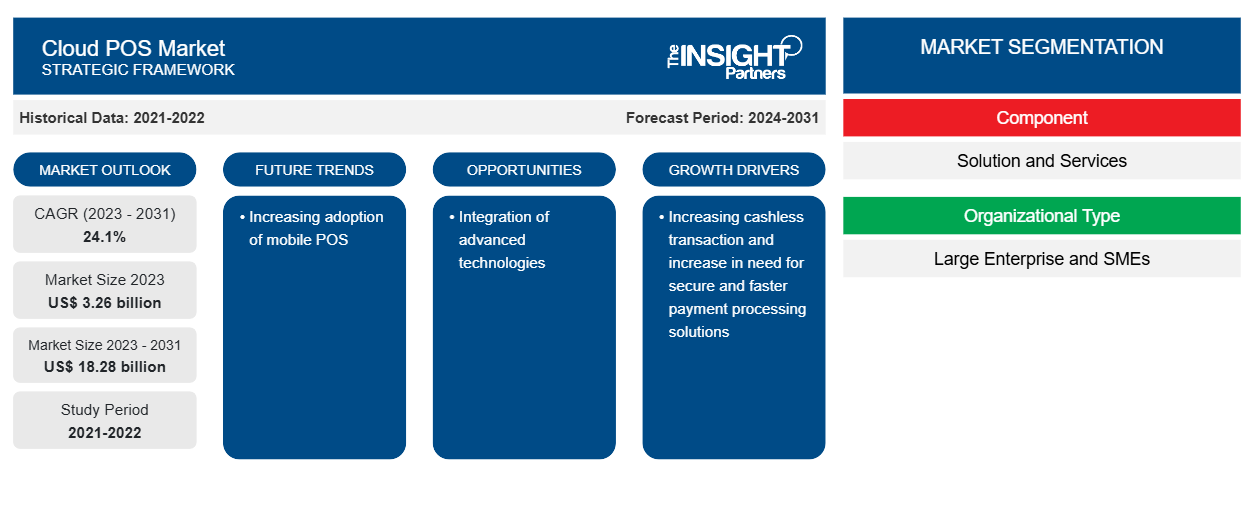클라우드 POS 시장 규모는 2023년 32억 6천만 달러에서 2031년 182억 8천만 달러로 성장할 것으로 예상되며, 2023년에서 2031년까지 연평균 성장률 24.1%로 성장할 것으로 추산됩니다. 모바일 POS 채택 증가는 클라우드 POS 시장의 주요 트렌드로 남을 가능성이 높습니다.
클라우드 POS 시장 분석
클라우드 POS(Point of Sale) 시장은 최근 몇 년 동안 상당한 성장과 변화를 경험했습니다. 클라우드 기반 POS 시스템은 기존 온프레미스 솔루션에 대한 인기 있는 대안으로 등장하여 기업에 더 높은 유연성, 확장성 및 접근성을 제공합니다. 이러한 시스템은 클라우드 컴퓨팅 기술을 사용하여 거래 데이터를 저장하고 처리하여 물리적 하드웨어의 필요성을 제거하고 실시간 연결을 제공합니다. 클라우드 기반 POS 시스템의 주요 이점 중 하나는 모든 규모의 기업에서 운영을 간소화하고 효율성을 높일 수 있다는 것입니다. 재고 관리, 판매 보고 및 분석, 고객 관계 관리 및 다른 비즈니스 애플리케이션과의 통합과 같은 기능을 제공합니다. 클라우드 POS를 사용하면 기업은 판매를 쉽게 추적하고 재고 수준을 모니터링하며 운영에 대한 귀중한 통찰력을 얻어 의사 결정을 개선하고 고객 경험을 향상시킬 수 있습니다. 클라우드 기반 POS는 소매, 호텔, 레스토랑 및 전자 상거래를 포함한 다양한 산업에서 널리 채택되었습니다. 특히 중소기업은 저렴하고 구현이 용이하기 때문에 클라우드 POS 솔루션을 채택했습니다. 게다가, POS 클라우드 기반 시스템의 확장성 덕분에 기업은 운영을 확장하고 필요에 따라 추가 기능을 쉽게 추가할 수 있습니다. 보안은 클라우드 POS 제공업체의 중요한 초점이었습니다.
클라우드 POS 시장 개요
클라우드 기반 POS 솔루션의 기본은 쉽게 상승하고 하락할 수 있다는 개념입니다. 회사는 필요에 따라 언제든지 서비스를 추가하거나 제거할 수 있습니다. 기업은 기존 온프레미스 POS의 실패 방지 메커니즘과 미래 지향적 요구 사항 대신 사용하는 서비스에 대한 비용을 지불하여 비용을 절감할 수 있습니다. 솔루션 제공자는 또한 클라우드 기반 POS 솔루션의 유지 관리 및 보수를 처리하므로 사업주는 이러한 POS 시스템이 지속적으로 실행되는 것에 대해 걱정할 필요가 없습니다.
귀하의 요구 사항에 맞게 이 보고서를 사용자 정의하세요
이 보고서의 일부 또는 국가 수준 분석, Excel 데이터 팩을 포함하여 모든 보고서에 대한 사용자 정의를 무료로 받을 수 있으며 신생 기업 및 대학을 위한 훌륭한 혜택과 할인 혜택을 이용할 수 있습니다.
- 이 보고서의 주요 시장 동향을 알아보세요.이 무료 샘플에는 시장 동향부터 추정 및 예측까지 다양한 데이터 분석이 포함됩니다.
클라우드 POS 시장 동인 및 기회
시장 성장을 촉진하기 위한 안전하고 빠른 결제 처리 솔루션에 대한 수요 증가
안전하고 빠른 결제 처리 솔루션에 대한 필요성의 증가는 클라우드 POS 시장 성장의 중요한 원동력이었습니다. 기업이 고객에게 원활하고 효율적인 결제 경험을 제공하기 위해 노력함에 따라 클라우드 기반 POS 시스템이 선호되는 선택으로 부상했습니다. 무엇보다도 클라우드 POS 솔루션은 민감한 결제 데이터를 보호하기 위한 향상된 보안 조치를 제공합니다. 강력한 암호화, 토큰화 및 PCI DSS(Payment Card Industry Data Security Standard)와 같은 산업 규범 준수를 통해 이러한 시스템은 거래 처리를 위한 안전한 환경을 제공합니다. 데이터 보안의 책임을 신뢰할 수 있는 클라우드 서비스 공급자에게 전가함으로써 기업은 데이터 침해 및 무단 액세스와 관련된 위험을 완화할 수 있습니다. 게다가 클라우드 POS 시스템은 더 빠른 결제 처리를 가능하게 하여 기업과 고객에게 이점을 제공합니다. 기존의 온프레미스 POS 시스템은 종종 수동 업데이트 및 유지 관리가 필요하여 잠재적인 지연 및 비효율성을 초래합니다.
높은 거래량을 처리할 수 있는 능력 - 클라우드 POS 시장의 기회
클라우드 기반 POS 시스템은 많은 거래량을 처리할 수 있습니다. 휴일이나 프로모션 이벤트와 같은 성수기에는 기업이 고객 트래픽과 결제 거래가 급증하는 것을 경험합니다. 클라우드 POS 시스템은 리소스를 쉽게 확장하여 수요 증가에 대처하고, 중단 없는 결제 처리를 보장하고, 고객 좌절이나 판매 기회 손실로 이어질 수 있는 병목 현상을 피할 수 있습니다. 게다가 클라우드 POS 솔루션은 다양한 결제 방법 및 채널과 통합 기능을 제공합니다. 모바일 지갑, 비접촉 결제 옵션, 온라인 결제 게이트웨이와 원활하게 연결하여 고객에게 광범위한 선택권을 제공하고 편의성을 향상시킬 수 있습니다. 결제 수용의 이러한 유연성은 기업이 진화하는 고객 선호도에 부응하고 변화하는 산업 동향에 적응하는 데 도움이 됩니다.
클라우드 POS 시장 보고서 세분화 분석
클라우드 POS 시장 분석 도출에 기여한 주요 세그먼트는 구성 요소, 조직 유형 및 최종 사용자입니다.
- 클라우드 POS 시장은 구성 요소를 기준으로 솔루션과 서비스로 구분됩니다.
- 조직 유형에 따라 클라우드 POS 시장은 대기업과 중소기업으로 구분됩니다.
- 클라우드 POS 시장은 최종 사용자를 기준으로 소매 및 소비재, 여행 및 호텔, 미디어 및 엔터테인먼트, 운송 및 물류, 의료 및 기타로 구분됩니다.
지역별 클라우드 POS 시장 점유율 분석
- 클라우드 POS 시장은 북미, 유럽, 아시아 태평양(APAC), 중동 및 아프리카(MEA), 남미 및 중미의 5개 주요 지역으로 구분됩니다. 아시아 태평양 지역은 2023년에 시장을 장악했으며, 소매 및 호텔 부문에서 첨단 기술 솔루션에 대한 채택이 증가하고 수요가 증가했습니다. 이 지역의 강력한 경제 성장, 확장되는 전자 상거래 산업, 높아진 고객 기대치는 클라우드 POS 부문에서 상당한 시장 점유율을 차지하는 데 기여했습니다. 클라우드 기반 POS 솔루션은 모든 규모의 기업에 비용 효율적이고 확장 가능한 옵션을 제공할 수 있는 능력으로 인해 아시아 태평양 지역에서 주목을 받고 있습니다.
클라우드 POS 시장 지역 통찰력
Insight Partners의 분석가들은 예측 기간 동안 클라우드 POS 시장에 영향을 미치는 지역적 추세와 요인을 철저히 설명했습니다. 이 섹션에서는 북미, 유럽, 아시아 태평양, 중동 및 아프리카, 남미 및 중미의 클라우드 POS 시장 세그먼트와 지리적 분포도 논의합니다.

- 클라우드 POS 시장에 대한 지역별 데이터 얻기
클라우드 POS 시장 보고서 범위
| 보고서 속성 | 세부 |
|---|---|
| 2023년 시장 규모 | 32억 6천만 달러 |
| 2031년까지 시장 규모 | 182억 8천만 달러 |
| 글로벌 CAGR (2023-2031) | 24.1% |
| 역사적 데이터 | 2021-2022 |
| 예측 기간 | 2024-2031 |
| 다루는 세그먼트 | 구성 요소별로
|
| 포함된 지역 및 국가 | 북아메리카
|
| 시장 선도 기업 및 주요 회사 프로필 |
|
클라우드 POS 시장 참여자 밀도: 비즈니스 역학에 미치는 영향 이해
클라우드 POS 시장 시장은 소비자 선호도의 변화, 기술 발전, 제품의 이점에 대한 인식 증가와 같은 요인으로 인해 최종 사용자 수요가 증가함에 따라 빠르게 성장하고 있습니다. 수요가 증가함에 따라 기업은 제품을 확장하고, 소비자의 요구를 충족하기 위해 혁신하고, 새로운 트렌드를 활용하여 시장 성장을 더욱 촉진하고 있습니다.
시장 참여자 밀도는 특정 시장이나 산업 내에서 운영되는 회사나 기업의 분포를 말합니다. 주어진 시장 공간에 얼마나 많은 경쟁자(시장 참여자)가 존재하는지 그 규모나 총 시장 가치에 비해 나타냅니다.
클라우드 POS 시장에서 운영되는 주요 회사는 다음과 같습니다.
- 주식회사 스퀘어
- 인튜이트 주식회사
- 오라클 주식회사
- 쇼피파이 주식회사
- 주식회사 토스트
- 벤드 리미티드
면책 조항 : 위에 나열된 회사는 어떤 특별한 순서에 따라 순위가 매겨지지 않았습니다.

- 클라우드 POS 시장의 주요 기업 개요를 알아보세요
클라우드 POS 시장 뉴스 및 최근 개발
클라우드 POS 시장은 1차 및 2차 조사 이후의 정성적, 정량적 데이터를 수집하여 평가되며, 여기에는 중요한 기업 간행물, 협회 데이터 및 데이터베이스가 포함됩니다. 다음은 클라우드 POS 시장의 개발 목록입니다.
- 2022년 9월, Square, Inc.(현재 Block, Inc.로 알려짐)는 미국 전역의 수백만 개의 공급업체에 iPhone의 Tap to Pay 기능을 소개했습니다. Square Point of Sale iOS 앱에서 사용할 수 있는 이 기능을 통해 모든 규모의 상인은 추가 하드웨어 요구 사항 없이, 판매자에게 추가 비용 없이 iPhone에서 직접 비접촉 결제를 수락할 수 있었습니다.
(출처: Square, Inc., 보도자료)
- 2022년 6월, Openbravo는 퀵서비스 레스토랑(QSR)과 패스트 캐주얼 레스토랑을 위한 새로운 POS(Point-of-Sale) 출시를 발표했습니다. 이 솔루션의 주요 기능으로는 빠르고 유연한 메뉴 생성과 레스토랑 지역 및 배달 모드에 따른 특정 가격 정의와 같은 옵션이 있는 강력한 가격 엔진이 있습니다.
(출처: Openbravo, 보도자료)
클라우드 POS 시장 보고서 범위 및 제공물
"클라우드 POS 시장 규모 및 예측(2021-2031)"은 아래에 언급된 영역을 포괄하는 시장에 대한 자세한 분석을 제공합니다.
- 범위에 포함된 모든 주요 시장 세그먼트에 대한 글로벌, 지역 및 국가 수준의 클라우드 POS 시장 규모 및 예측
- 클라우드 POS 시장 동향(동력, 제약, 주요 기회 등)
- 클라우드 POS 시장 동향
- 자세한 PEST/포터의 5가지 힘과 SWOT 분석
- 주요 시장 동향, 주요 업체, 규정 및 최근 시장 동향을 포괄하는 글로벌 및 지역 시장 분석
- 시장 집중도, 히트맵 분석, 유명 업체 및 최근 개발 사항을 포함하는 클라우드 POS 시장 산업 현황 및 경쟁 분석
- 자세한 회사 프로필
- 과거 분석(2년), 기준 연도, CAGR을 포함한 예측(7년)
- PEST 및 SWOT 분석
- 시장 규모 가치/거래량 - 글로벌, 지역, 국가
- 산업 및 경쟁 환경
- Excel 데이터세트
최근 보고서
사용 후기
구매 이유
- 정보에 기반한 의사 결정
- 시장 역학 이해
- 경쟁 분석
- 고객 인사이트
- 시장 예측
- 위험 완화
- 전략 기획
- 투자 타당성 분석
- 신흥 시장 파악
- 마케팅 전략 강화
- 운영 효율성 향상
- 규제 동향에 발맞춰 대응





















 무료 샘플 받기 - 클라우드 POS 시장
무료 샘플 받기 - 클라우드 POS 시장